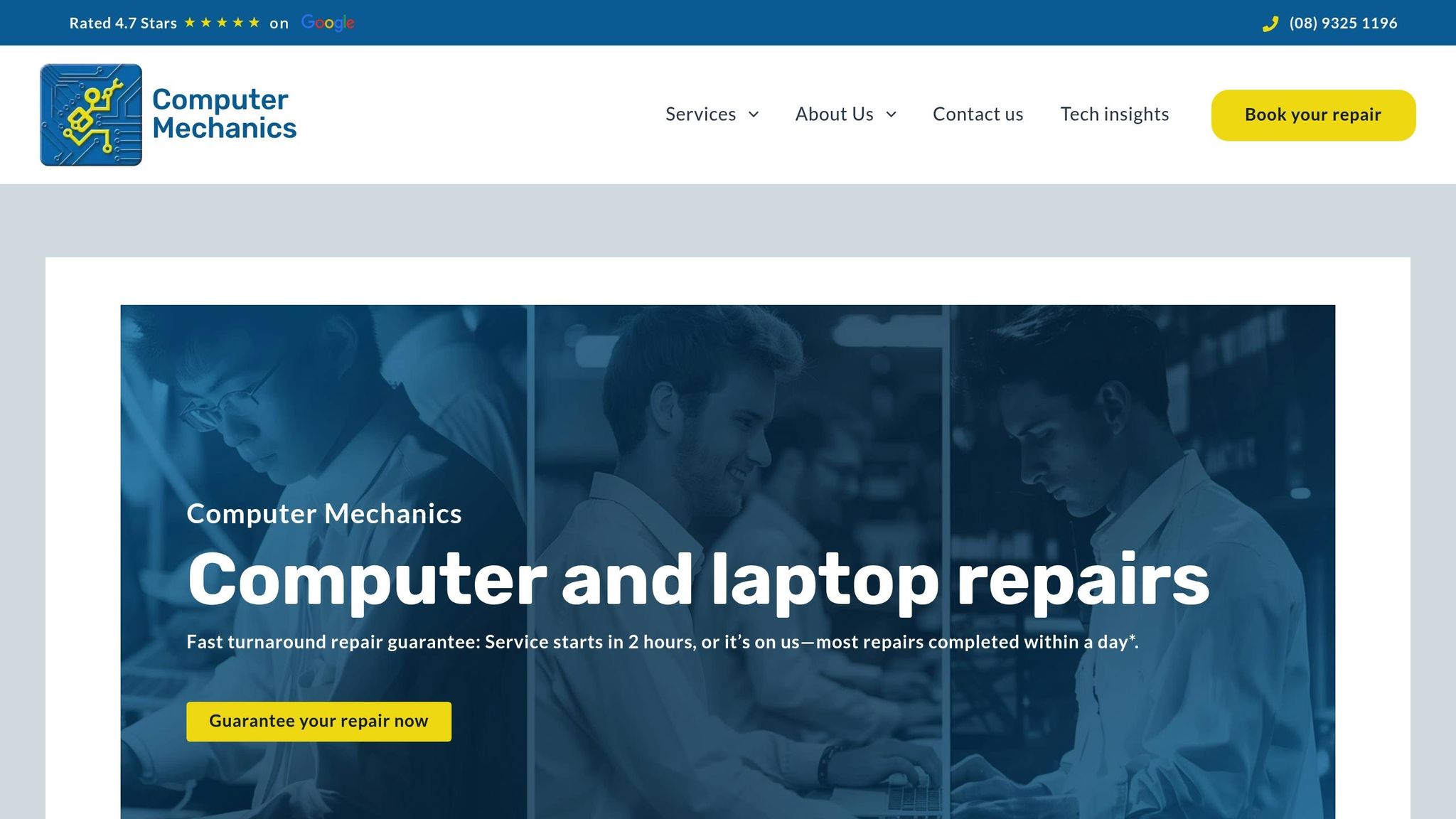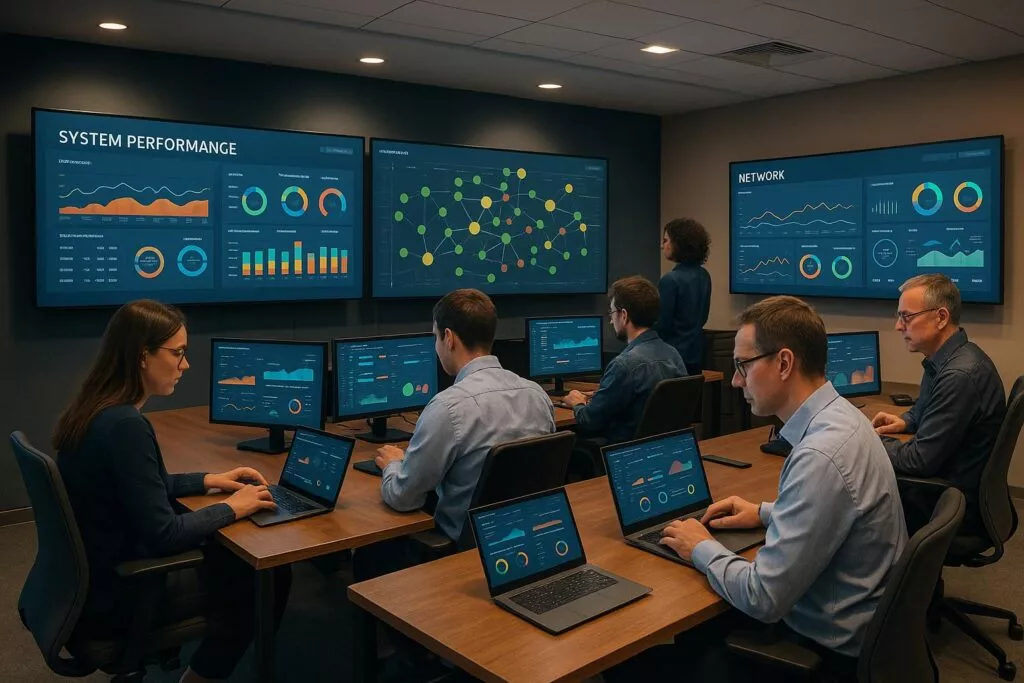Efficient IT maintenance is essential for minimizing downtime, cutting costs, and keeping systems reliable. Here’s how businesses can manage IT resources effectively:
- Skilled Teams: Ensure your IT staff has expertise in hardware, software, and cybersecurity.
- Fast Responses: Address urgent repairs quickly while maintaining regular preventive maintenance.
- Proactive Monitoring: Use system monitoring to catch problems early and reduce emergency fixes.
- Cost-Effective Strategies: Balance budgets with flexible solutions like managed IT services.
For example, Computer Mechanics Perth offers quick repair services (most completed in 24 hours), skilled technical support, and managed services to keep businesses running smoothly. Their structured approach includes preventive care, reactive solutions, and transparent pricing.
Quick Comparison Table:
| Approach | Benefits | Challenges |
|---|---|---|
| Managed IT Services | Reduces in-house IT costs; proactive care | May depend on external providers |
| Preventive Maintenance | Avoids major failures; improves uptime | Requires regular monitoring and effort |
| Reactive Maintenance | Solves immediate issues | Can lead to higher costs over time |
Key takeaway: Align IT maintenance strategies with your business needs by combining skilled teams, proactive monitoring, and cost-effective solutions.
Information Technology (IT) Enabled Maintenance Management
1. Computer Mechanics Perth Services

Computer Mechanics Perth focuses on IT maintenance by ensuring quick responses, skilled technical support, and efficient resource use.
Quick Response and Efficient Resource Use
The company emphasizes fast service, starting repairs within 2 hours and completing most within 24 hours [1]. This approach helps reduce downtime and keep businesses running smoothly. Here’s a breakdown of how they manage resources:
| Resource Type | Allocation Strategy | Business Impact |
|---|---|---|
| Technical Staff | Assigning skilled technicians as needed | Faster issue resolution |
| Time Management | Guaranteeing a 2-hour response time | Reduced system downtime |
| Service Delivery | Completing most repairs within 24 hours | Better business continuity |
This system ensures that technical expertise is used effectively and downtime is kept to a minimum.
Specialized Technical Skills
The team at Computer Mechanics Perth is well-versed in several key areas, including:
- Data transfer and backups
- Hardware repairs and upgrades
- Cybersecurity measures and privacy setups
- System optimization and software updates
This range of skills allows them to handle IT challenges efficiently and effectively.
Managed Services for Better Performance
Their managed services include network management, cybersecurity, software handling, and technical support. This dual approach blends preventive care with reactive solutions, ensuring systems run smoothly while avoiding expensive downtime.
"We believe in good service at a fair price. Our pricing is transparent so you get the best value without any surprises." – Computer Mechanics Perth [1]
With over 250 positive reviews [1], their transparent pricing and structured service model highlight their commitment to customer satisfaction and system reliability. This balanced approach to IT maintenance helps businesses stay ahead of potential issues.
2. Standard IT Maintenance Approaches
Resource-Based Allocation Model
Modern IT maintenance prioritizes resources based on how critical a system is. This approach helps reduce downtime and ensures essential systems get the attention they need. It’s a key part of most maintenance strategies.
Time-Based Distribution
This method divides maintenance efforts into three categories: preventive, reactive, and proactive tasks.
- Preventive maintenance includes regular updates, backups, and system health checks to avoid problems before they arise.
- Reactive maintenance deals with unexpected issues, like system failures or bugs, as they happen.
- Proactive maintenance focuses on planning ahead, such as scheduling upgrades or improving system performance.
By spreading efforts across these areas, this approach ensures systems stay functional and adaptable to changing needs.
Skills-Based Assignment
Assigning tasks based on expertise improves efficiency and system reliability. Here’s how it works:
- System Monitoring and Updates: Regular monitoring, especially during off-peak hours, ensures smooth operation with minimal disruption.
- Emergency Response Protocol: Clear steps for handling urgent issues enable teams to respond quickly and effectively.
- Preventive Maintenance: Routine checks, software updates, and security patches help avoid potential failures.
Combining these targeted tasks with strategic oversight ensures a well-maintained IT environment.
Resource Optimization Strategies
To get the most out of available resources, focus on systems that have the biggest impact. Automated monitoring tools can help track performance and allocate resources where they’re needed most. Additionally, having clear escalation protocols ensures complex issues are handled efficiently.
Performance Metrics
Key metrics like response times, resolution rates, and system uptime provide valuable insights. These measurements help teams make better decisions about resource allocation and improve overall system performance.
sbb-itb-078dd21
Benefits and Limitations
Managed IT services offer a structured way to handle IT maintenance, helping businesses allocate resources more effectively. The approach used by Computer Mechanics Perth highlights both the advantages and challenges of this model.
| Maintenance Approach | Benefits | Limitations |
|---|---|---|
| Managed IT Services | • Lowers in-house IT expenses • Delivers proactive maintenance and access to technical experts • Offers flexible service levels |
• Can lead to reliance on external providers • Response times may vary due to parts availability or issue complexity • Service coverage might have restrictions |
This comparison provides a foundation for analyzing the cost and quality aspects of managed IT services.
Cost-Effectiveness Analysis
Managed IT services are a practical choice for businesses looking to manage IT tasks without hiring full-time staff. These services typically include system monitoring, software updates, preventive maintenance, expert support, and cybersecurity. They are designed to fit the budgets of businesses of various sizes, making them an economical option.
Service Quality Considerations
Computer Mechanics Perth is known for its reliable service, completing most repairs within 24 hours. Their consistent performance showcases their ability to handle diverse IT maintenance tasks effectively.
Flexibility and Scalability
Managed IT services adapt to changing business requirements. They provide flexible service options, access to specialized expertise, quick problem resolution, and tailored support plans.
Key Findings and Recommendations
Strategic IT maintenance resource planning, particularly through managed services, can lead to noticeable cost savings and improved efficiency.
Resource Allocation Framework
Effective IT resource allocation should reflect a business’s size and operational complexity. Here’s a breakdown of approaches:
- Small businesses: Relying on fully managed IT services simplifies maintenance and provides access to expert support.
- Medium-sized businesses: A hybrid model that combines in-house resources with selective outsourcing works well.
- Large enterprises: Custom solutions that integrate full-scale infrastructure management with dedicated support teams are ideal.
The goal is to align IT resource allocation with the specific needs of the business.
Implementation Guidelines
For effective IT maintenance resource allocation, focus on these critical steps:
-
Infrastructure Assessment
Regular assessments, like those offered by Computer Mechanics Perth, can help identify and address potential issues before they grow. -
Cost Monitoring
Track essential metrics such as downtime costs, ticket resolution times, hardware life cycles, and software license usage to ensure cost efficiency. -
Performance Benchmarking
Set clear performance metrics to evaluate the success of your maintenance strategy. Real-time monitoring tools allow for proactive issue resolution and adjustments.
These steps provide a solid foundation for maintaining a resilient IT environment.
Future-Proofing Recommendations
To keep your IT maintenance strategy effective over time:
- Allocate part of your IT budget for preventive maintenance.
- Conduct regular technology audits to spot potential improvements.
- Use automated monitoring systems to streamline issue detection.
- Maintain detailed records of maintenance activities and procedures.
- Periodically review and update your maintenance protocols to stay current with technological advancements.
FAQs
What are the main advantages of using managed IT services for efficient IT maintenance?
Managed IT services provide businesses with a cost-effective way to handle IT maintenance without the need to hire full-time IT staff. These services ensure that your technology infrastructure is secure, up-to-date, and running efficiently.
By outsourcing IT maintenance, businesses can focus on their core operations while leaving tasks like system monitoring, updates, and troubleshooting to experienced professionals. This approach not only reduces downtime but also helps prevent costly technical issues before they arise.
What’s the best way for businesses to balance preventive, reactive, and proactive IT maintenance strategies?
Finding the right balance between preventive, reactive, and proactive IT maintenance depends on your business’s unique needs and goals. Start by evaluating your current IT infrastructure, identifying potential risks, and understanding the cost implications of each approach.
Preventive maintenance helps avoid issues before they occur, while reactive maintenance focuses on addressing problems as they arise. Proactive strategies, on the other hand, aim to predict and resolve issues before they impact operations. Combining these methods strategically ensures both efficiency and reliability.
For businesses seeking expert guidance, professional managed IT services can help streamline this process, ensuring your technology operates securely and efficiently.
What are the key metrics to evaluate the performance and cost-effectiveness of IT maintenance strategies?
To effectively measure the performance and cost-effectiveness of IT maintenance strategies, companies should focus on a few essential metrics:
- Downtime Duration: Track the total time systems are unavailable. Lower downtime indicates a well-maintained IT infrastructure.
- Mean Time to Repair (MTTR): Measure how quickly issues are resolved. Faster repair times reflect efficient resource allocation.
- Maintenance Costs: Monitor expenses related to repairs, upgrades, and preventive maintenance to ensure they align with your budget and goals.
- System Reliability: Evaluate the frequency of system failures or disruptions. High reliability reduces long-term costs and improves productivity.
By consistently analyzing these metrics, businesses can identify areas for improvement, optimize resource usage, and ensure their IT systems operate efficiently and cost-effectively.

